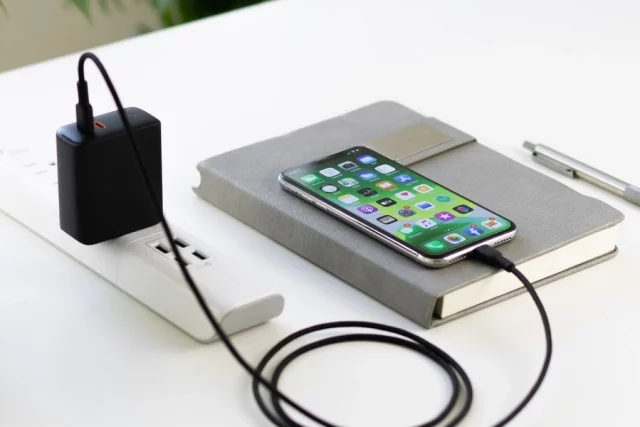Why is my phone dying on the charger? Charging your phone should be a seamless operation. Most modern flagship smartphones allow for fast and efficient charging. Using USB C and lightning charging options for iPhones is a game-changer.
The problem arises when you plug your phone into a charger, but the battery keeps draining. We shall discuss the causes, solutions, and how to prevent the issue. To find the solutions, we must answer one important question:
Why is My Phone Dying on the Charger?
There are many reasons why your phone is draining while plugged in. The common cause for the issue is using a faulty charger. The charger isn’t delivering enough power to charge the battery despite the charging animation on the notification bar.
When this happens, try using a different charger. Always use a charger recommended by your phone’s manufacturer to avoid any charging issues.
Other Common Causes For Draining When Charging
A faulty charger causes most issues related to drainage while charging. There are other common causes for this type of drainage. They include
Damaged Charging Port
A damaged charging port causes your phone to drain, despite the charging indicator. The charging port has a power delivery system that allows you to plug your phone into an outlet.
The port gets damaged over time, mostly due to wear and tear. USB C ports are more durable and less susceptible to damage than USB mini ports.
Another cause could be an obstruction of the power delivery system in the port. It could be due to the charging pin receptors being bent out of shape. It could also be due to dust and lint particles accumulating inside the charging port.
Clean the port and try charging your phone. If the pins are bent or the port is damaged, you need to replace it.
Faulty Power Brick
It’s not just the cable that could cause issues with charging. Power bricks have important circuitry that ensures efficient power delivery.
These power bricks are robust depending on the delivery requirements. A malfunctioning component could cause the power delivery performance to reduce.
Power bricks are durable, and most of them even outlast our phones. Replacements should be easy, as they are easy to find in retail shops. Use a power brick that delivers the correct wattage to avoid phantom charging.
Power Source
The power source plays a key role in charging your device. You want a power source that delivers enough wattage to charge your device.
Charging from a low voltage power source will make it appear like the phone is charging, but it will drain slowly.
You will likely experience the drains when you charge your phone from your laptop or computer.
The best way to charge is directly from the wall. Some power banks have insufficient power delivery while others do well.
If the power output is too high, it will damage your battery. Check the power rating to keep your phone safe.
Overheating
Your phone may stop charging while plugged in if it is overheating. It is a safety feature built into many smartphones.
Charging exposes your phone to extra heat. The charging stops if the phone’s internal temperature exceeds a set limit.
If your phone is overheating, unplug it and switch it off. Please wait for it to cool down and try charging it when it is off.
If your phone overheats while charging, you should check your plug point’s power rating. You should also check the power brick as it could be faulty. In extreme cases, heating issues could cause your battery to explode, causing injuries and fire.
Your Battery Needs Calibration
Battery calibration helps your phone’s software read the battery correctly. Calibration is a necessity in older phones due to battery degradation.
Calibration fixes inaccurate battery readings, making it appear like your phone is draining when plugged in.
Here Are Some Tips To Make Your Battery Last Longer
Running out of battery can be inconvenient, especially when you can’t access a charging point. You should try and make your phone’s charge last as long as possible.
Follow these tips to maximize your phone’s battery life:
Reduce your screen on time
Leaving your phone’s screen on consumes more power than having apps run in the background. It is especially true for OLED devices, where your phone has to light each pixel.
Reducing your screen on time will significantly improve your battery life. Let your screen go off after about 30 seconds of being idle. You can change the screen on time when doing tasks like reading.
Lower your brightness settings
Your battery life depends on your phone’s brightness. A bright screen uses more power than a dim screen. You should lower your brightness if you are using your phone in a well-lit environment.
Phones have a blue light filter under the display settings. The filter helps with minimizing eye strain and also saves you battery. It dims the white pixels, making the display easier to use and lowering consumption.
Use dark mode
Dark Mode is a feature that allows you to change your phone’s interface appearance. It uses a black background with white text for your user interface. Using dark mode is great because it reduces eye strain.
Dark mode lowers your battery consumption. Most of the pixels on your display get turned off. It means that you use less power for nearly all tasks.
Dark mode is helpful for all apps that support it. It works well both indoors and outdoors. Using dark mode could extend your battery life by up to 20%.
Turn off haptic feedback.
Haptic feedback produces light vibration rumbles as you use your phone. It makes for a great typing experience and is sometimes necessary for meetings.
Haptic feedback, however, is not great for your battery life. The vibrations draw energy from the battery as it channels current through the motors.
Turn off haptic feedback on your settings to improve your battery life and make your charge last longer.
Turn off data roaming.
Data roaming is a setting that lets your phone access signals within your provider’s territory, even in other countries.
The setting is great when traveling as it allows you to use your preferred network. Turn the setting off when you are not traveling.
Data roaming drains your battery faster than you might realize.
Use a 4G network when you can
Use 4G instead of 5G whenever you can. 5G gives you unbelievably fast internet speeds but comes at a great cost for your battery life.
You do not need to use 5G internet for most tasks on your phone. 4G is great for streaming in 4K, getting high-quality video and audio calls, etc.
4G is better for your battery as it consumes less power. You can switch to 4G on your network settings for better battery life.
Update your phone’s software
Phone manufacturers release OTA updates for their devices. These updates optimize the phone’s efficiency and fix minor bugs and issues. Updates could help your phone reduce battery consumption when running certain applications.
Set your phone to update automatically to get the latest battery optimization features and keep your device running smoothly.
Lower your screen’s refresh rate
The refresh rate refers to the frequency of still images per second on your screen. Most flagships have 120Hz refresh rate settings. It creates a great user experience, particularly when scrolling through applications or playing games.
Running your phone’s display at a higher refresh rate consumes more power. Your phone’s graphics processor draws more power to keep the screen active. Running the display at 60Hz is great as it lowers consumption.
Wireless Or Wired Charging?
Wireless charging is a new feature for smart devices. It allows you to charge your phone by laying it on an electromagnetic induction surface.
But how does it compare to wired charging? Is it better? Wireless charging does have its benefits and disadvantages.
Wireless charging is convenient, especially if built into a desk or accessible surface. It is also great for charging many devices simultaneously.
Wireless charging is, however, less efficient than wired charging. It uses more energy than regular charging. It is also slower than wired charging.
Conclusion
Why is my phone dying on the charger? The most common cause for phones dying while charging is using a faulty charger. Phones have varying power intake requirements, and using the wrong charger often means insufficient power delivery. Try using a different charger.
If using a different charger doesn’t work, the issue could be with the power source or the phone’s charging port. USB mini ports are fragile and more susceptible to damage caused by wear and tear. A low voltage power source causes slow power delivery to the battery.














